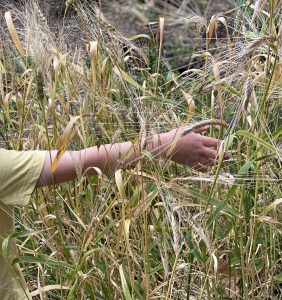
Before the bread, the flour
Before the flour, the mill
Before the mill, the grain
The sun, the earth, the rain
Here we are, already entering harvest season. The blackberries are starting to darken, and the figs are softening on the tree. This past week we harvested wheat from our own tiny “wheat field” in the schoolyard. The children and I have been watching it grow since the spring, first the tender green shoots, then the tall grass, then the soft green seed heads. Then we watched the green start to turn to gold, until the seed heads were heavy with wheat berries and had long golden whiskers. It has been an exciting transformation, and the mixture of green and gold is certainly lovely to look at. Next week on painting day we’ll experiment with green and yellow watercolors to evoke our outdoor experience with these colors.
Watching and harvesting this wheat has brought on some unexpected feelings and reflections. For one thing, it ripened sooner than I expected, perhaps due to the record-breaking heat wave that hit Portland late last month, prompting me to consider: How do we help children celebrate nature while we ourselves may be anxious about changes occurring in the natural world? Whether or not July is actually an early time for the wheat to ripen in the Pacific Northwest (I’m not sure), these are valuable things to consider in early childhood care and parenting. 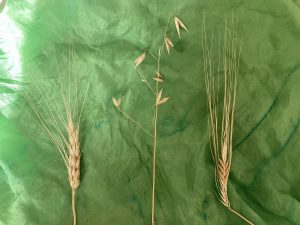 My own answer to this question is a simple one, and probably a good answer to plenty of other questions: Encourage the children to notice. Model noticing these things, with simple joy– “Ah, the wheat is turning golden! This year it is ripening in July. Do you see how fat the little seeds are, inside their golden skins? They are almost ready to harvest.” Offer language to connect to the information that the children are absorbing sensorially. It is so tempting, as adults, to editorialize– but regardless of our feelings about something, being fully present to it is almost always the best response that we can model for children. If we are to raise good stewards of the environment, the first thing we must teach is deep, non-anxious noticing. We cannot care about a plant, for instance, if we never deeply notice it: where and how it grows, its textures and colors and smells, the cycle of its life. We must teach not only how to know about the world, but how to be in relationship with it.
My own answer to this question is a simple one, and probably a good answer to plenty of other questions: Encourage the children to notice. Model noticing these things, with simple joy– “Ah, the wheat is turning golden! This year it is ripening in July. Do you see how fat the little seeds are, inside their golden skins? They are almost ready to harvest.” Offer language to connect to the information that the children are absorbing sensorially. It is so tempting, as adults, to editorialize– but regardless of our feelings about something, being fully present to it is almost always the best response that we can model for children. If we are to raise good stewards of the environment, the first thing we must teach is deep, non-anxious noticing. We cannot care about a plant, for instance, if we never deeply notice it: where and how it grows, its textures and colors and smells, the cycle of its life. We must teach not only how to know about the world, but how to be in relationship with it.
While young children naturally drink in everything they perceive with their senses (they need no help with that part), they are also watching us very closely to see how we interact with our surroundings. We are the ones who indicate to them whether or not it is important to notice and interact with the natural world as grown-up humans. I see the children watching me out of the corner of my eye as I brush my hand slowly through the wheat stalks and seed heads– back and forth, back and forth. Two days later, I see a child do the same thing with a soft smile on his face. He is deep in wordless conversation with the ripening wheat.
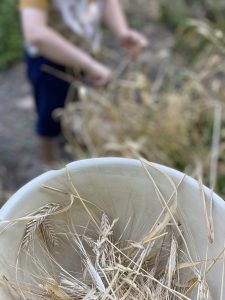 So, after all of this watching and noticing, we finally arrived at the wheat harvest. The children helped me snip the stalks supporting the seed heads, and place them in a pale yellow ceramic bowl. Then they wanted to keep snipping the dry stems, which I encouraged them to do, saying: “Yes, let’s harvest the straw, too! You know, the quails like to make their beds in straw. You can take the pieces you harvest and poke them through into the nest box.” Which led to a lot of vigorous back-and-forth across the yard, putting new sweet-smelling straw into the quails’ beds. One child noticed that the straw was hollow, wondered aloud if they could drink through it, and then made the connection that the same word is used to describe a drinking straw and a wheat straw. As far as I am concerned, this is preschool science at its best. At this tender age, reveling in the beauty and wonder of nature is precisely the same thing as practicing the observational skills of a scientist.
So, after all of this watching and noticing, we finally arrived at the wheat harvest. The children helped me snip the stalks supporting the seed heads, and place them in a pale yellow ceramic bowl. Then they wanted to keep snipping the dry stems, which I encouraged them to do, saying: “Yes, let’s harvest the straw, too! You know, the quails like to make their beds in straw. You can take the pieces you harvest and poke them through into the nest box.” Which led to a lot of vigorous back-and-forth across the yard, putting new sweet-smelling straw into the quails’ beds. One child noticed that the straw was hollow, wondered aloud if they could drink through it, and then made the connection that the same word is used to describe a drinking straw and a wheat straw. As far as I am concerned, this is preschool science at its best. At this tender age, reveling in the beauty and wonder of nature is precisely the same thing as practicing the observational skills of a scientist. 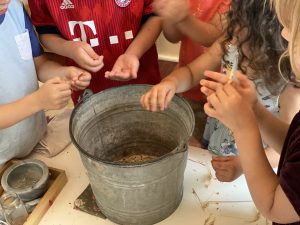
The following day, we threshed and winnowed the ripe wheat. All of the children enjoyed this, the youngest and oldest alike. The more methodical older children stuck with the task of threshing the seed heads in a steel bucket until all of the wheat berries had all been loosened from the stalk, while the youngest especially enjoyed the winnowing process (sorting the grain from the chaff), delighting in the little “tink” sound of a freshly liberated wheat berry dropping into a ceramic dish. She called her friends by name, making sure that everyone heard and appreciated that little sound! As we worked, I softly sang a song I learned in a Waldorf school, about harvesting the golden grain and milling it into flour for bread. 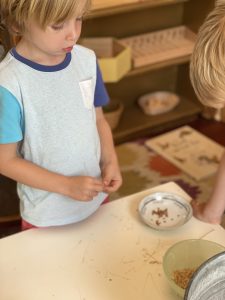 For me, this was a beautiful moment of experiencing the magic that can happen in the creative overlap of Waldorf and Montessori: Waldorf because of the reverent way in which we were celebrating the wheat (both for its role in the world at large and for its part in the rhythms of our daily life), and Montessori because of the way some of the children sank into such beautiful concentration when presented with the tasks of threshing and winnowing, once I had prepared the activities and given them a lesson on how to do it. Focus, fine-motor skills, hand-eye coordination, a gentle touch, attention to detail– all of these things were being developed in the process of threshing and winnowing. The children who were most hungry for these challenges stuck with the activity, and those who were satisfied drifted away to other play or work as we meandered comfortably toward afternoon snack time.
For me, this was a beautiful moment of experiencing the magic that can happen in the creative overlap of Waldorf and Montessori: Waldorf because of the reverent way in which we were celebrating the wheat (both for its role in the world at large and for its part in the rhythms of our daily life), and Montessori because of the way some of the children sank into such beautiful concentration when presented with the tasks of threshing and winnowing, once I had prepared the activities and given them a lesson on how to do it. Focus, fine-motor skills, hand-eye coordination, a gentle touch, attention to detail– all of these things were being developed in the process of threshing and winnowing. The children who were most hungry for these challenges stuck with the activity, and those who were satisfied drifted away to other play or work as we meandered comfortably toward afternoon snack time.
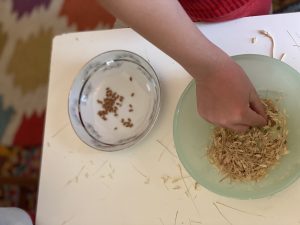
Next month, when I bring in some more songs about harvesting grain, the children will know exactly what I mean. They’ll understand what “threshing” means in the lyrics of Scarborough Fair, and they’ll remember harvesting fresh straw when they hear about the golden straw in the story of Rumpelstiltskin. They’ll understand the job of the millers they meet in fairy tales, and they’ll know where flour comes from. And more than this: the sensory experience of harvesting and processing wheat will be kept forever in the children’s minds-hearts-bodies like a little stash of gold, as will all of their sensory experiences before age 5 or 6. According to Montessori, preschool is about helping children build vivid and precise sensory impressions, so that when they move into a capacity for abstract thought, their foundation of sensory building blocks will enable them to develop rich capacities for imagination, spiritual experience, artistic sense, scientific inquiry, and mathematical thought.
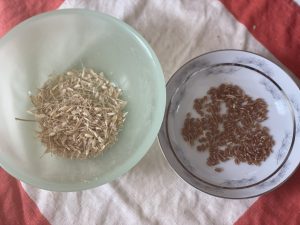
And all of this from a small dish of wheat berries! They won’t make very much flour when we grind them to add to our bread dough next Tuesday, but that isn’t really the true harvest.
